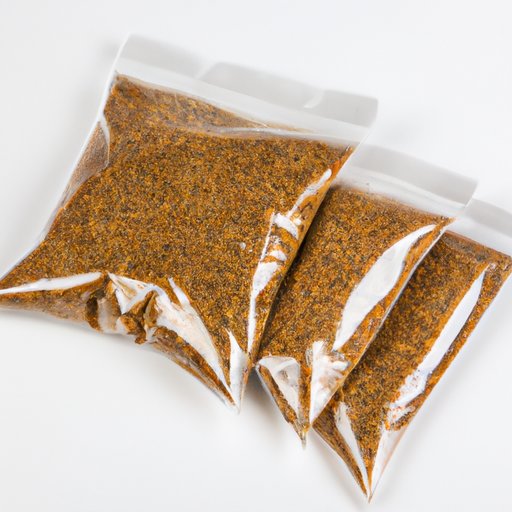
Introduction
Cooking a turkey for a special occasion like Thanksgiving is a great way to bring family and friends together. However, traditional methods of cooking a turkey can be time-consuming and difficult to get right. Cooking a turkey in a bag is a popular alternative that can make the process easier and provide several benefits. In this article, we will provide a comprehensive step-by-step guide to cooking a turkey in a bag, discuss the health benefits, troubleshoot common problems, suggest different seasoning options, recommend different types of bags to use, and provide creative ideas for using leftover turkey.
Step-by-step guide
To cook a turkey in a bag, you will need the following ingredients and tools:
- A turkey
- A turkey bag (oven or roasting bags work best)
- Seasonings (salt, pepper, and garlic powder are good options)
- Butter or oil (to rub on the turkey)
- Baking sheet
- Mixing spoon
- Meat thermometer
Step 1: Preheat your oven to 350°F (175°C) and make sure there is enough room for the turkey and bag to fit inside.
Step 2: Season the turkey with salt, pepper, and garlic powder on both the inside and outside. Rub butter or oil all over the turkey to enhance its flavor.
Step 3: Open the turkey bag and put it on the baking sheet. Place the turkey inside the bag, making sure the turkey fits snugly without touching the sides of the bag.
Step 4: Tie the bag closed with the included tie. Cut six 1-inch slits in the top of the bag to allow steam to escape.
Step 5: Bake the turkey in the preheated oven for about 3-4 hours, depending on the size of the turkey. Use a meat thermometer to ensure that the turkey has reached an internal temperature of 165°F (75°C).
Step 6: Remove the turkey from the oven and let it rest for 10-15 minutes before removing it from the bag to serve.
It is important to note that safety measures should be taken during the cooking process, such as washing hands and utensils thoroughly, cooking the turkey to the correct temperature, and using a meat thermometer to ensure the turkey is cooked properly.
Health benefits of using a turkey bag
Cooking a turkey in a bag can provide several health benefits, such as enhanced flavor and moisture retention. A study published in the Journal of Food Science found that cooking a turkey in a bag increased the moisture content and resulted in a juicier and more tender turkey compared to traditional roasting methods.
Using a turkey bag also reduces the risk of contamination by preventing the turkey from coming into contact with other foods or surfaces during the cooking process. This can promote healthier eating habits and help prevent foodborne illnesses.
Troubleshooting tips
While cooking a turkey in a bag is generally a straightforward process, there are some common problems that can occur. Here are some tips for how to avoid or fix these issues:
- If the bag melts, try using a double-layered bag to prevent it from happening again.
- If the turkey sticks to the bag, try adding extra oil or butter to the turkey before placing it inside the bag. You can also sprinkle flour inside the bag before adding the turkey to prevent sticking.
- If the turkey is not browning on top, remove the turkey from the bag during the last 30 minutes of cooking to allow it to brown evenly.
Different types of bags to use
There are different types of bags available for cooking a turkey in a bag, such as oven bags or roasting bags. Oven bags are made from heat-resistant nylon and are designed to withstand high temperatures. Roasting bags are made from thicker materials and are more durable, but can be more expensive.
Both types of bags work well for cooking a turkey in a bag, but oven bags are better for smaller turkeys, while roasting bags are better for larger turkeys. It is important to follow the manufacturer’s instructions when using either type of bag and to consult the packaging for recommended cooking temperatures.
Vegan-friendly options
If you are vegan or have dietary restrictions, you can still enjoy the benefits of cooking a turkey in a bag. There are several plant-based ingredients that can be used as substitutes for traditional turkey ingredients, such as vegan meat or tempeh. You can also experiment with different seasoning options that are vegan-friendly, such as rosemary, thyme, or sage.
Different seasoning options
Seasoning a turkey in a bag is important to enhance its flavor and aroma. There are several different seasoning options that can be used, such as herbs, spices, or sauces.
Some popular seasoning options include:
- Rosemary, thyme, and sage
- Paprika, cumin, and chili powder
- Garlic and onion powder
- Lemon zest and parsley
- Cranberry sauce or gravy
Feel free to experiment with your own seasoning combinations to find what works best for you.
Creative ways to use leftover turkey
Minimizing food waste is important, and using leftover turkey in creative ways can be a fun and delicious way to do so. Here are some ideas:
- Turkey soup or stew
- Turkey tacos
- Turkey sandwiches with cranberry sauce or gravy
- Turkey salad with mixed greens and cranberries
- Turkey patty or meatballs
Feel free to use your imagination and come up with your own leftover turkey recipes.
Conclusion
While cooking a turkey can be a daunting task, cooking a turkey in a bag can make the process easier and provide several benefits. In this article, we provided a step-by-step guide to cooking a turkey in a bag, discussed the health benefits, troubleshooted common problems, suggested different seasoning options, recommended different types of bags to use, and provided creative ideas for using leftover turkey. We encourage readers to try cooking a turkey in a bag, experiment with different herbs and spices, and share their experience with others.




